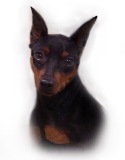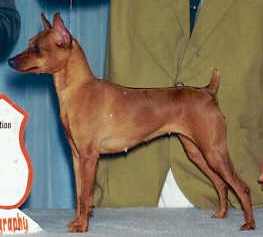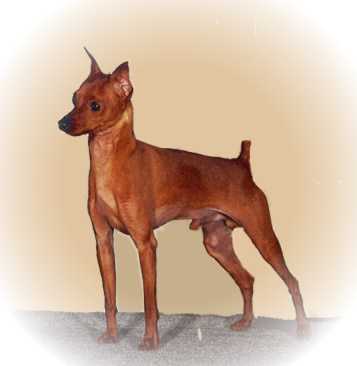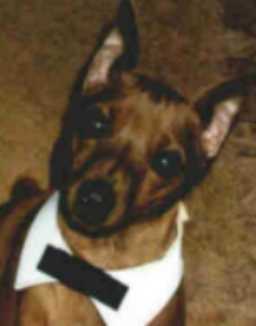The Miniature Pinscher ( Min Pin ) originated in
It is also sometimes known by several other names Zwerg Pinscher (Zwerg means dwarf in German), Toy Pinscher, Dwarf Pinscher, Deer Pinscher).
Careful research has led us to believe this breed originated from the Short Haired German Pinscher, possibly the
Although he looks like a miniature version of the Doberman Pinscher, he is not related. The miniature pinscher is actually 200 years older than the Doberman pinscher and was a recognized breed in  CH WEESKELF SORCERER'S ONYX SPELL
CH WEESKELF SORCERER'S ONYX SPELL
MBPIS/MBIS Can / Am CH WEESKELF JOTHONA ZABRI (Zabri won her first BIS at 11 months of age at the London Ont. show beating over 2000 dogs!) Bred by Sue Caillier (Weeskelf) and owned/loved by Gerona MacCuaig (Jothona).
By 1920, the Miniature Pinschers started to be exported to the
The min pin was developed and was originally used to hunt rats in stables. Pinschers have been used as ratters for over 300 years.Ears were cropped and tails docked so that when a rat was caught it could not turn it's head around and grab the dog's ear or tail.
This sleek, elegant breed with the quick, ‘hackney’ gait is perhaps the "busiest" and most intense of the toy breeds. Assertive and proud, athletic and agile, the Miniature Pinscher is convinced that he's a big dog. He seems to be in perpetual motion and enjoys brisk, vigorous, interactive games.
Keenly observant and territorial, the Miniature Pinscher takes his watchdog role seriously, often showing strangers his backside accompanied by defiant kicking of the ground with his rear feet. Early and frequent socialization is required so that he doesn't become sharp or shrill.
 CH WEESKELF LOOK BUT DON'T TOUCH
CH WEESKELF LOOK BUT DON'T TOUCH
Miniature Pinschers
What's good about 'em
What's bad about 'em
- There are energetic Min Pins, and placid Min Pins.
- Hard-headed Min Pins, and sweet-natured Min Pins.
- Serious Min Pins, and good-natured goofballs.
- Introverted Min Pins, and Min Pins who love everyone
- If you want a dog who ….
A Miniature Pinscher may be right for you.
If you don’t want to deal with ….
- A dynamic dog who seems to be in perpetual motion in to old age
- Providing enough exercise and activities to keep them busy
- Destructiveness when bored
- Extreme suspiciousness toward strangers
- Aggression toward other animals -- chasing instincts
- Escape attempts (over or under) or running away
- Strong-willed mind of his own, requiring a confident owner who can take charge
- Notorious housebreaking difficulties at start of training
- Barking
A Miniature Pinscher may not be right for you.
 KIDD-a Nubby Silk son 1990
KIDD-a Nubby Silk son 1990Considering a Miniature Pinscher - major concerns would be:
- Providing enough exercise and mental stimulation. Miniature Pinschers are active go-getters. They MUST have regular opportunities to vent their energy and to use their busy minds to do interesting things. Bored Min Pins can be extremely noisy and destructive.
- Suspiciousness. Standoffish by nature, Miniature Pinschers need extensive exposure to people and to unusual sights and sounds. Otherwise their natural caution can become extreme suspiciousness. Many Min Pins will put on a display of excited ferociousness (i.e. they "pitch a fit") when other people or animals approach what is THEIRS. It's not funny, because if you don't curtail it, your Min Pin may end up suspicious of everyone in the world, which is a short step to biting
- Animal aggression. Most Miniature Pinschers are dominant or aggressive toward other dogs. Most have strong instincts to chase and seize small fleeing creatures. This can make for conflict if you own a cat. It may be much worse than that if you own a pet rabbit or hamster!
- Fence security. Many Min Pins are clever escape artists who will go over or under fences in search of adventure. You may need higher fences than you might imagine for their small size. Some are climbers and will go right up and over a chain link fence of any height. You may also need to sink wire into the ground along the fence line to thwart digging.
- Mind of their own. Miniature Pinschers are not Golden Retrievers. Though very bright and willing to work with a confident trainer, they have an independent mind of their own and are not pushovers to raise and train. They can be manipulative, and some are willful, obstinate, and dominant (they want to be the boss) and will make you prove that you can make them do things. You must show them, through absolute consistency, that you mean what you say.
- Housebreaking. Toy breeds are almost always difficult to housebreak. It is so easy for them to sneak behind a chair or under a small table, and it takes only a few seconds for the deed to be done. The results can be hard to see. When you don't see it, you don't correct it -- and so the bad habit becomes established. If you hope to housebreak a Miniature Pinscher, consistent crate training is mandatory. They should not be loosed in the house for many months, until their small internal organs become strong enough for reliable control.
- Barking. Miniature Pinschers are often too quick to sound the alarm at every new sight and sound. You have to be equally quick to stop them. If you work all day and have close neighbors, Min Pins are not the best choice for you. For the same reason, Min Pins should NEVER be left outside in your yard, unsupervised.
If you are interested in a min pin to add to your home, but would like to possibly adopt from rescue, please visit Internet Miniature Pinscher Rescue Service (IMPS) where you can find many min pins in need of forever loving homes.
If you would like to contact a reputable/responsible breeder in your area, but need help finding one, please write us an e-mail and we will provide any assistance we can to make finding your special min pin easier.
If you would like to also look into Canadian Miniature Pinscher Club members for a puppy then please visit the CMPC BREEDERS Web Page for a breeder in your area.
www.cdn-miniaturepinscherclub.com
As we can not guarantee the actions of other breeders, even through referral, we are not liable/responsible for any problems or misunderstandings that may occur. We will try very hard to get you in touch with whom we feel is reputable and responsible but make sure you do your own research into each breeder you contact.